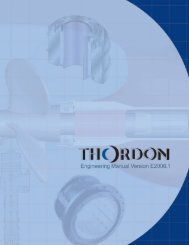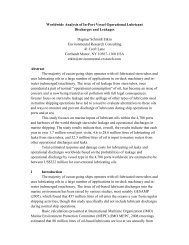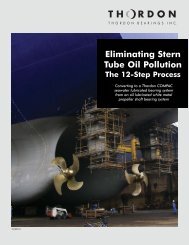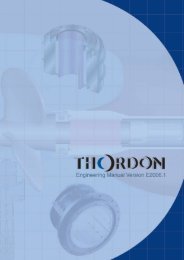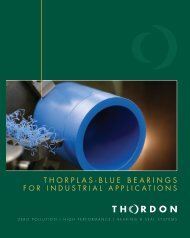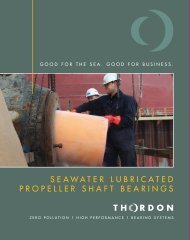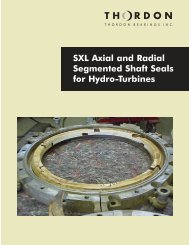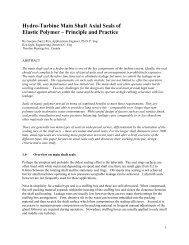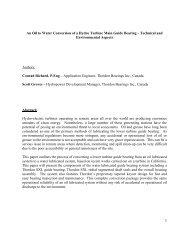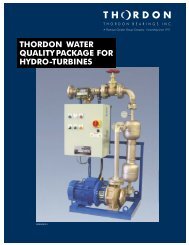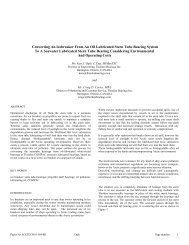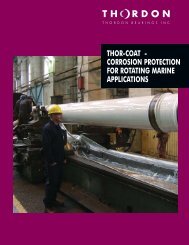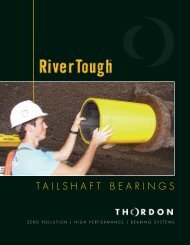Rudder Carrier Disks Brochure.qxd - Thordon Bearings
Rudder Carrier Disks Brochure.qxd - Thordon Bearings
Rudder Carrier Disks Brochure.qxd - Thordon Bearings
Create successful ePaper yourself
Turn your PDF publications into a flip-book with our unique Google optimized e-Paper software.
SXL <strong>Rudder</strong><br />
<strong>Carrier</strong> <strong>Bearings</strong>
THORDON SXL RUDDER CARRIER BEARINGS<br />
Introduction<br />
<strong>Thordon</strong> SXL rudder carrier bearings (discs) are a<br />
complementary product to the established and<br />
proven SXL rudder pintle and stock bearings. Made<br />
from a high strength elastomeric polymer developed<br />
by <strong>Thordon</strong> <strong>Bearings</strong>, rudder carrier bearings are<br />
designed to support the rudder weight, allow the<br />
rudderstock to turn freely and accommodate rudder<br />
stock deflection. <strong>Thordon</strong> has also developed a new<br />
high performance rudder stock seal to complement<br />
the above and below waterline <strong>Thordon</strong> rudder<br />
bearing package.<br />
ADVANTAGES<br />
Eliminate or Reduce Greasing<br />
<strong>Thordon</strong> SXL is an excellent alternative to the<br />
conventional bronze rudder carrier bearing. The<br />
primary advantage of <strong>Thordon</strong> SXL is its low<br />
coefficient of friction. This enables it to operate with<br />
little or no grease. In most of the new ships built<br />
using <strong>Thordon</strong> SXL rudder carrier discs, the builders<br />
have eliminated the automatic greasing system and<br />
replaced it with a less expensive and more<br />
environmentally friendly manual system. <strong>Thordon</strong><br />
SXL can operate dry in most carrier disc<br />
applications, but grease is often used to protect the<br />
carbon steel components in the system from<br />
corroding<br />
Tolerance to Edge Loading<br />
In comparison to bronze bearings, the increased<br />
elastic deformability of <strong>Thordon</strong> SXL rudder carrier<br />
bearings enables them to better accommodate<br />
uneven and impact loading. This leads to reduced<br />
peak pressures (edge loading) and minimizes the<br />
local wear of the carrier bearing resulting in longer<br />
operating life. The elastomeric nature of <strong>Thordon</strong><br />
enables it to recover from impact loading without the<br />
permanent deformation commonly found with<br />
bronze. <strong>Thordon</strong> is also much more abrasion<br />
resistant than bronze.<br />
Guaranteed Long Bearing Wear Life<br />
As with <strong>Thordon</strong> SXL pintle and rudder stock<br />
bearings, <strong>Thordon</strong> <strong>Bearings</strong> also guarantees SXL<br />
<strong>Carrier</strong> <strong>Bearings</strong> in newbuild classed vessels as<br />
follows:<br />
<strong>Thordon</strong> SXL <strong>Rudder</strong> <strong>Carrier</strong> <strong>Bearings</strong> will<br />
meet Class Society wear specifications for<br />
15 years or <strong>Thordon</strong> <strong>Bearings</strong> lnc. will<br />
supply a new bearing free of charge.<br />
Easy Handling - Lightweight Compared to<br />
Bronze<br />
<strong>Thordon</strong> SXL also has a significant handling<br />
advantage over large bronze bearings, both in terms<br />
of weight (as indicated by the example below) and<br />
in terms of risk of damage during handling. <strong>Thordon</strong><br />
SXL rudder carrier bearings can be supplied split or<br />
not split to suit virtually any size of rudder.<br />
<strong>Carrier</strong> Disk Material C93200 Bronze <strong>Thordon</strong> SXL<br />
<strong>Carrier</strong> Disk Weight*<br />
*Based on rudder carrier dimensions of 800mm x 600mm x 25mm<br />
(31.50”x 23.62”x0.98”)<br />
Split SXL <strong>Rudder</strong> <strong>Carrier</strong> Bearing<br />
49 kg (108 lbs.) 6.4 kg (14 lbs.)<br />
Typical Arrangement of a <strong>Rudder</strong> <strong>Carrier</strong><br />
Bearing in <strong>Rudder</strong> System<br />
A typical arrangement of a rudder carrier bearing<br />
with a radial bearing below is shown in Figure1.<br />
Occasionally, a radial bearing will be located above<br />
the carrier bearing.<br />
Figure 1<br />
Location of carrier bearing
Grooving<br />
If a <strong>Thordon</strong> SXL rudder carrier bearing is to be<br />
greased, proper grooving is essential for achieving<br />
optimal performance. Figure 2 shows the groove<br />
pattern and geometry for a proven design. Grooving<br />
should ensure adequate grease injection around the<br />
circumference, and ensure that the grease is<br />
adequately spread over the whole bearing surface.<br />
Specific groove design can be provided on a caseby-case<br />
basis as required.<br />
Typical SXL rudder carrier bearing Installed in housing<br />
Material<br />
<strong>Thordon</strong> SXL is used for rudder carrier applications<br />
due to the low coefficient of friction that allows it to<br />
operate either dry or greased. It also has the inherent<br />
flexibility that enables it to adjust to shock and edge<br />
loading. It is approved by the major marine<br />
Classification Societies for rudder bearing<br />
applications up to 12 MPa (1740 psi). Studies of<br />
actual loads on rudder carrier bearings indicate that<br />
they are normally designed considerably less than<br />
12 MPa (1740 psi) and are therefore well within the<br />
working range of <strong>Thordon</strong> SXL.<br />
Lubrication<br />
Although <strong>Thordon</strong> SXL has the ability to run dry in<br />
most rudder bearing applications, the normal<br />
procedure with large rudder carrier bearings is to<br />
lubricate with grease. Grease is used mainly to<br />
protect metal parts of the system from corroding, but<br />
it can also reduce friction and increase wear life of<br />
the carrier bearing in relatively clean environments.<br />
The greasing system for a <strong>Thordon</strong> SXL carrier<br />
bearing can be less complex than what is required<br />
for a bronze bearing because <strong>Thordon</strong> is capable of<br />
operating in a marginally greased condition as well<br />
as dry. In most newbuild installations with <strong>Thordon</strong><br />
SXL rudder carrier bearings, the automatic greasing<br />
system has been replaced with a manual system.<br />
This reduces equipment cost, the amount of grease<br />
required and also eliminates pollution from the<br />
excess grease that an automatic system typically<br />
produces.<br />
<strong>Thordon</strong> SXL can be designed to operate dry in<br />
rudder carrier applications as long as the metallic<br />
parts of the system do not require grease to prevent<br />
corrosion.<br />
Figure 2<br />
SXL rudder carrier disc showing greasing grooves<br />
Bearing Housing<br />
The carrier bearing housing should have a shoulder<br />
on the outside diameter (O.D.) with a height of 0.3 to<br />
0.5 times the carrier bearing thickness – see Figure<br />
3. The shoulder secures the position of the carrier<br />
bearing. This is especially important when split<br />
bearings are used. The shoulder also improves the<br />
stiffness of the bearing by limiting its ability to spread.<br />
When <strong>Thordon</strong> SXL bearings are bonded into place,<br />
there should also be a shoulder on the I.D.<br />
Figure 3<br />
<strong>Rudder</strong> carrier housing design
Installation<br />
<strong>Thordon</strong> SXL rudder carrier bearings are normally<br />
installed either by fastening with screws, or by<br />
bonding using a <strong>Thordon</strong> approved adhesive.<br />
Bolting can be accomplished using bolts with<br />
shoulders or countersunk head cap screws with<br />
metal inserts fitted into the bearing. These are used<br />
to prevent excessive tightening of the bolts, causing<br />
deflection of the SXL.<br />
Bonded <strong>Thordon</strong> SXL rudder carrier bearings should<br />
be fitted into housings that have shoulders designed<br />
into both the O.D. and I.D. sections. Detailed mixing,<br />
application and curing instructions for the chosen<br />
adhesive must be followed.<br />
Classification Society Approvals<br />
<strong>Thordon</strong> SXL carrier bearings are approved by many<br />
of the major Classification Societies either<br />
specifically or as part of their general rudder bearing<br />
approval. Approved pressure is in the range of 10-12<br />
MPa (1450-1740psi).<br />
References<br />
<strong>Thordon</strong> SXL rudder carrier bearings have been<br />
installed in more than 300 vessels over the past 15<br />
years, with the majority installed in new ships built in<br />
South Korea. A detailed reference list is available<br />
from <strong>Thordon</strong> <strong>Bearings</strong> Inc.<br />
Split vs. Non Split <strong>Carrier</strong> <strong>Bearings</strong><br />
<strong>Thordon</strong> SXL rudder carrier bearings can be<br />
designed split or non-split. In many designs split<br />
carrier bearings are required to facilitate installation.<br />
In terms of installation procedures and load bearing<br />
capacity, there is no difference between split and<br />
non-split bearings.<br />
Your Local <strong>Thordon</strong> Distributor<br />
T H O R D O N B E A R I N G S I N C.<br />
ZERO POLLUTION | HIGH PERFORMANCE | BEARING SYSTEMS<br />
SXL<strong>Rudder</strong>.01.2010<br />
3225 Mainway Drive, Burlington, Ontario L7M 1A6 Canada<br />
Tel: +1.905.335.1440 Fax: +1.905.335.4033<br />
www.<strong>Thordon</strong><strong>Bearings</strong>.com<br />
ISO 9001:2008<br />
CGSB<br />
Registration #93649



